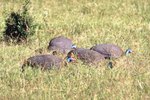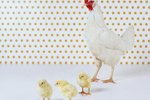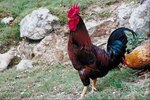Why do some chicken eggs end up as cute, fluffy little chicks and others end up in the refrigerated section of your favorite grocer? The difference is the rooster. Baby chickens come from eggs that were fertilized by a rooster, while the eggs we eat were not. The rooster’s reproductive system, similar to that of most other male fowl, is a relatively simple system that operates in much the same way as the human male’s reproductive system, minus a few key organs.
Testes
A rooster does not have an external scrotum; however, he does have testes. Located high in the abdominal cavity in front of the kidney and near the backbone, the two bean-shaped testes consist of many slender ducts. The lining of these ducts produces sperm. The testes shrink and grow on a regular basis, becoming larger during active mating. Often the left testis is larger than the right one. In addition to creating sperm, the testes also produce the male hormones that influence mating, male behavior, the comb growth atop their heads, the size of the tail feathers, the spurs on the insides of their feet and the red wattles under their chins.
Deferent Ducts
The deferent ducts, similar to the vas deferens in human males, carry the sperm to the papilla and eventually the cloaca, which is the rooster’s reproductive opening. The ducts start out narrowly next to the testes and gradually widen as they near the papilla.
Papilla and Cloaca
Instead of an external organ resembling a penis, the rooster has a small bump, or papilla, located on the back wall of the cloaca under the tail feathers. The cloaca is the external opening both hens and roosters use to excrete urine and feces, and where eggs emerge from hens. The sperm that travelled from the testes and through the deferent ducts exit the rooster through the cloaca via the papilla and is transferred to the hen while mating.
Sperm
It typically takes about 15 days for a rooster’s sperm to form. He will produce approximately 35,000 sperm each second of his life, and his semen contains approximately 40 times as much sperm as a human male. However, quantity doesn’t always equal quality, and the rooster’s sperm quality depends on many factors, such as nutrition, genetics and environment.
Reproductive Process
When a rooster mates with a hen, he will climb on top of her back and place a foot on each of her wings, forcing her tail feathers upward so he can press his cloaca to hers. The rooster ejaculates and transfers the sperm, and he hops off. Often he will perform a victory dance of sorts, hopping around and strutting, while the hen unruffles her feathers, flaps her wings and walks away.
References
Photo Credits
-
Jupiterimages/Photos.com/Getty Images
Writer Bio
Maelin McCartney began writing professionally in 2010. She holds undergraduate degrees from Hastings College in health and developmental psychology, family studies psychology, personality and social psychology and sociology with an emphasis in criminal justice. She is currently pursuing a master’s degree in counseling at Doane University.





